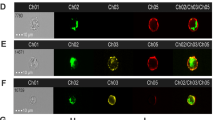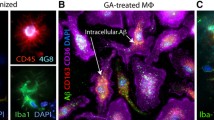Abstract
Alzheimer’s disease (AD) is a neurodegenerative disease characterized by extracellular amyloid beta (Aβ) deposition and intracellular neurofibrillary tangle formation. Monocyte is part of the innate immune system and can effectively remove dead cells and debris. It has been suggested that Aβ can recruit monocytes into brain in AD mice, resulting in restriction of cerebral amyloidosis. However, monocyte may act as a double-edged sword, either beneficial (e.g., clearance of Aβ) or detrimental (e.g., secretion of neurotoxic factors). In addition, recent studies indicate that in AD patients, Aβ phagocytosis by monocytes is ineffective. The present review mainly summarized the current knowledge on monocytes and their potential roles in AD.
摘要
阿尔茨海默病(Alzheimer’s disease, AD)是神经退行性疾病中最常见的类型。 胞外β淀粉样蛋白(amyloid beta, Aβ)的沉积和胞内神经原纤维的缠结是典型的AD神经病理学特征。 单核细胞是天然免疫细胞, 可以有效清除坏死细胞及碎片。 在AD模型鼠上的许多实验研究表明, Aβ可以使单核细胞向大脑募集, 从而限制脑内的淀粉样变性。 然而, 单核细胞也是一把双刃剑: 一方面它可以清除Aβ, 另一方面它又能分泌神经毒性因子, 损伤神经细胞。 此外, 近来也有研究表明, 在AD患者脑内, 单核细胞并不能有效清除Aβ沉积。 本综述主要对单核细胞及其在AD中的潜在角色进行讨论。
Similar content being viewed by others
References
Selkoe DJ. Defining molecular targets to prevent Alzheimer disease. Arch Neurol 2005, 62(2): 192–195.
Parihar MS, Hemnani T. Alzheimer’s disease pathogenesis and therapeutic interventions. J Clin Neurosci 2004, 11(5): 456–467.
Samandouras G, Teddy PJ, Cadoux-Hudson T, Ansorge O. Amyloid in neurosurgical and neurological practice. J Clin Neurosci 2006, 13(2): 159–167.
Zlokovic BV, Yamada S, Holtzman D, Ghiso J, Frangione B. Clearance of amyloid beta-peptide from brain: transport or metabolism? Nat Med 2000, 6(7): 718–719.
Seta N, Kuwana M. Human circulating monocytes as multipotential progenitors. Keio J Med 2007, 56(2): 41–47.
Fiala M, Lin J, Ringman J, Kermani-Arab V, Tsao G, Patel A, et al. Ineffective phagocytosis of amyloid-beta by macrophages of Alzheimer’s disease patients. J Alzheimers Dis 2005, 7(3): 221–232; discussion 55–62.
Hickman SE, El Khoury J. Mechanisms of mononuclear phagocyte recruitment in Alzheimer’s disease. CNS Neurol Disord Drug Targets 2010, 9(2): 168–173.
Whitelaw DM, Batho HF. The distribution of monocytes in the rat. Cell Tissue Kinet 1972, 5(3): 215–225.
Fogg DK, Sibon C, Miled C, Jung S, Aucouturier P, Littman DR, et al. A clonogenic bone marrow progenitor specific for macrophages and dendritic cells. Science 2006, 311(5757): 83–87.
Whitelaw DM. Observations on human monocyte kinetics after pulse labeling. Cell Tissue Kinet 1972, 5(4): 311–317.
Gordon S, Taylor PR. Monocyte and macrophage heterogeneity. Nat Rev Immunol 2005, 5(12): 953–964.
Stöhr J, Schindler G, Rothe G, Schmitz G. Enhanced upregulation of the Fc gamma receptor IIIa (CD16a) during in vitro differentiation of ApoE4/4 monocytes. Arterioscler Thromb Vasc Biol 1998, 18(9): 1424–1432.
Rothe G, Herr AS, Stohr J, Abletshauser C, Weidinger G, Schmitz G. A more mature phenotype of blood mononuclear phagocytes is induced by fluvastatin treatment in hypercholesterolemic patients with coronary heart disease. Atherosclerosis 1999, 144(1): 251–261.
Schmitz G, Orso E, Rothe G, Klucken J. Scavenging, signalling and adhesion coupling in macrophages: implications for atherogenesis. Curr Opin Lipidol 1997, 8(5): 287–300.
Schmitz G, Leuthauser-Jaschinski K, Orso E. Are circulating monocytes as microglia orthologues appropriate biomarker targets for neuronal diseases? Cent Nerv Syst Agents Med Chem 2009, 9(4): 307–330.
Lutter D, Ugocsai P, Grandl M, Orso E, Theis F, Lang EW, et al. Analyzing M-CSF dependent monocyte/macrophage differentiation: expression modes and meta-modes derived from an independent component analysis. BMC Bioinformatics 2008, 9: 100.
Delamarre L, Pack M, Chang H, Mellman I, Trombetta ES. Differential lysosomal proteolysis in antigen-presenting cells determines antigen fate. Science 2005, 307(5715): 1630–1634.
Colton CA, Wilcock DM. Assessing activation states in microglia. CNS Neurol Disord Drug Targets 2010, 9(2): 174–191.
Woollard KJ, Geissmann F. Monocytes in atherosclerosis: subsets and functions. Nat Rev Cardiol 2010, 7(2): 77–86.
Kimura S, Sawada T. Understanding the essential role of monocytes in atherosclerosis. Circ J 2010, 74(7): 1292–1293.
Nilsson J, Nordin Fredrikson G, Schiopu A, Shah PK, Jansson B, Carlsson R. Oxidized LDL antibodies in treatment and risk assessment of atherosclerosis and associated cardiovascular disease. Curr Pharm Des 2007, 13(10): 1021–1030.
Randolph GJ. The fate of monocytes in atherosclerosis. J Thromb Haemost 2009, 7Suppl 1: 28–30.
Chang CC, Wright A, Punnonen J. Monocyte-derived CD1a+ and CD1a− dendritic cell subsets differ in their cytokine production profiles, susceptibilities to transfection, and capacities to direct Th cell differentiation. J Immunol 2000, 165(7): 3584–3591.
Lawson LJ, Perry VH, Dri P, Gordon S. Heterogeneity in the distribution and morphology of microglia in the normal adult mouse brain. Neuroscience 1990, 39(1): 151–170.
Graeber MB, Streit WJ. Perivascular microglia defined. Trends Neurosci 1990, 13(9): 366.
Soulet D, Rivest S. Microglia. Curr Biol 2008, 18(12): R506–508.
Schlachetzki JC, Hull M. Microglial activation in Alzheimer’s disease. Curr Alzheimer Res 2009, 6(6): 554–563.
Aarum J, Sandberg K, Haeberlein SL, Persson MA. Migration and differentiation of neural precursor cells can be directed by microglia. Proc Natl Acad Sci U S A 2003, 100(26): 15983–15988.
Walton MR, Gibbons H, MacGibbon GA, Sirimanne E, Saura J, Gluckman PD, et al. PU.1 expression in microglia. J Neuroimmunol 2000, 104(2): 109–115.
Ladeby R, Wirenfeldt M, Dalmau I, Gregersen R, Garcia-Ovejero D, Babcock A, et al. Proliferating resident microglia express the stem cell antigen CD34 in response to acute neural injury. Glia 2005, 50(2): 121–131.
Chan WY, Kohsaka S, Rezaie P. The origin and cell lineage of microglia: new concepts. Brain Res Rev 2007, 53(2): 344–354.
Streit WJ. Microglial activation and neuroinflammation in Alzheimer’s disease: a critical examination of recent history. Front Aging Neurosci 2010, 2: 22.
Ajami B, Bennett JL, Krieger C, Tetzlaff W, Rossi FM. Local selfrenewal can sustain CNS microglia maintenance and function throughout adult life. Nat Neurosci 2007 10(12): 1538–1543.
D’Mello C, Le T, Swain MG. Cerebral microglia recruit monocytes into the brain in response to tumor necrosis factoralpha signaling during peripheral organ inflammation. J Neurosci 2009, 29(7): 2089–2102.
Soulet D, Rivest S. Bone-marrow-derived microglia: myth or reality? Curr Opin Pharmacol 2008, 8(4): 508–518.
Shechter R, London A, Varol C, Raposo C, Cusimano M, Yovel G, et al. Infiltrating blood-derived macrophages are vital cells playing an anti-inflammatory role in recovery from spinal cord injury in mice. PLoS Med 2009, 6(7): e1000113.
Hickey WF, Kimura H. Perivascular microglial cells of the CNS are bone marrow-derived and present antigen in vivo. Science 1988, 239(4837): 290–292.
Stoll G, Jander S. The role of microglia and macrophages in the pathophysiology of the CNS. Prog Neurobiol 1999, 58(3): 233–247.
Pilling D, Fan T, Huang D, Kaul B, Gomer RH. Identification of markers that distinguish monocyte-derived fibrocytes from monocytes, macrophages, and fibroblasts. PLoS One 2009, 4(10): e7475.
El Khoury J, Toft M, Hickman SE, Means TK, Terada K, Geula C, et al. Ccr2 deficiency impairs microglial accumulation and accelerates progression of Alzheimer-like disease. Nat Med 2007, 13(4): 432–438.
Frei K, Siepl C, Groscurth P, Bodmer S, Schwerdel C, Fontana A. Antigen presentation and tumor cytotoxicity by interferon-gammatreated microglial cells. Eur J Immunol 1987, 17(9): 1271–1278.
Panek RB, Benveniste EN. Class II MHC gene expression in microglia. Regulation by the cytokines IFN-gamma, TNF-alpha, and TGF-beta. J Immunol 1995, 154(6): 2846–2854.
Shrikant P, Weber E, Jilling T, Benveniste EN. Intercellular adhesion molecule-1 gene expression by glial cells. Differential mechanisms of inhibition by IL-10 and IL-6. J Immunol 1995, 155(3): 1489–1501.
Banati RB, Gehrmann J, Czech C, Monning U, Jones LL, Konig G, et al. Early and rapid de novo synthesis of Alzheimer beta A4-amyloid precursor protein (APP) in activated microglia. Glia 1993, 9(3): 199–210.
Simard AR, Soulet D, Gowing G, Julien JP, Rivest S. Bone marrowderived microglia play a critical role in restricting senile plaque formation in Alzheimer’s disease. Neuron 2006, 49(4): 489–502.
Town T, Laouar Y, Pittenger C, Mori T, Szekely CA, Tan J, et al. Blocking TGF-beta-Smad2/3 innate immune signaling mitigates Alzheimer-like pathology. Nat Med 2008, 14(6): 681–687.
Guerreiro RJ, Santana I, Bras JM, Santiago B, Paiva A, Oliveira C. Peripheral inflammatory cytokines as biomarkers in Alzheimer’s disease and mild cognitive impairment. Neurodegener Dis 2007, 4(6): 406–412.
Heneka MT, Sastre M, Dumitrescu-Ozimek L, Dewachter I, Walter J, Klockgether T, et al. Focal glial activation coincides with increased BACE1 activation and precedes amyloid plaque deposition in APP[V717I] transgenic mice. J Neuroinflammation 2005, 2: 22.
Meyer-Luehmann M, Spires-Jones TL, Prada C, Garcia-Alloza M, de Calignon A, Rozkalne A, et al. Rapid appearance and local toxicity of amyloid-beta plaques in a mouse model of Alzheimer’s disease. Nature 2008, 451(7179): 720–724.
McGeer PL, McGeer EG. The inflammatory response system of brain: implications for therapy of Alzheimer and other neurodegenerative diseases. Brain Res Brain Res Rev 1995, 21(2): 195–218.
Grathwohl SA, Kalin RE, Bolmont T, Prokop S, Winkelmann G, Kaeser SA, et al. Formation and maintenance of Alzheimer’s disease beta-amyloid plaques in the absence of microglia. Nat Neurosci 2009, 12(11): 1361–1363.
Sanchez-Ramos J, Song S, Sava V, Catlow B, Lin X, Mori T, et al. Granulocyte colony stimulating factor decreases brain amyloid burden and reverses cognitive impairment in Alzheimer’s mice. Neuroscience 2009, 163(1): 55–72.
Conductier G, Blondeau N, Guyon A, Nahon JL, Rovère C. The role of monocyte chemoattractant protein MCP1/CCL2 in neuroinflammatory diseases. J Neuroimmunol 2010, 244(1): 93–100.
Breitner JC, Welsh KA, Helms MJ, Gaskell PC, Gau BA, Roses AD, et al. Delayed onset of Alzheimer’s disease with nonsteroidal anti-inflammatory and histamine H2 blocking drugs. Neurobiol Aging 1995, 16(4): 523–530.
Mackenzie IR, Hao C, Munoz DG. Role of microglia in senile plaque formation. Neurobiol Aging 1995, 16(5): 797–804.
Author information
Authors and Affiliations
Corresponding author
Rights and permissions
About this article
Cite this article
Feng, Y., Li, L. & Sun, XH. Monocytes and Alzheimer’s disease. Neurosci. Bull. 27, 115–122 (2011). https://doi.org/10.1007/s12264-011-1205-3
Received:
Accepted:
Published:
Issue Date:
DOI: https://doi.org/10.1007/s12264-011-1205-3




